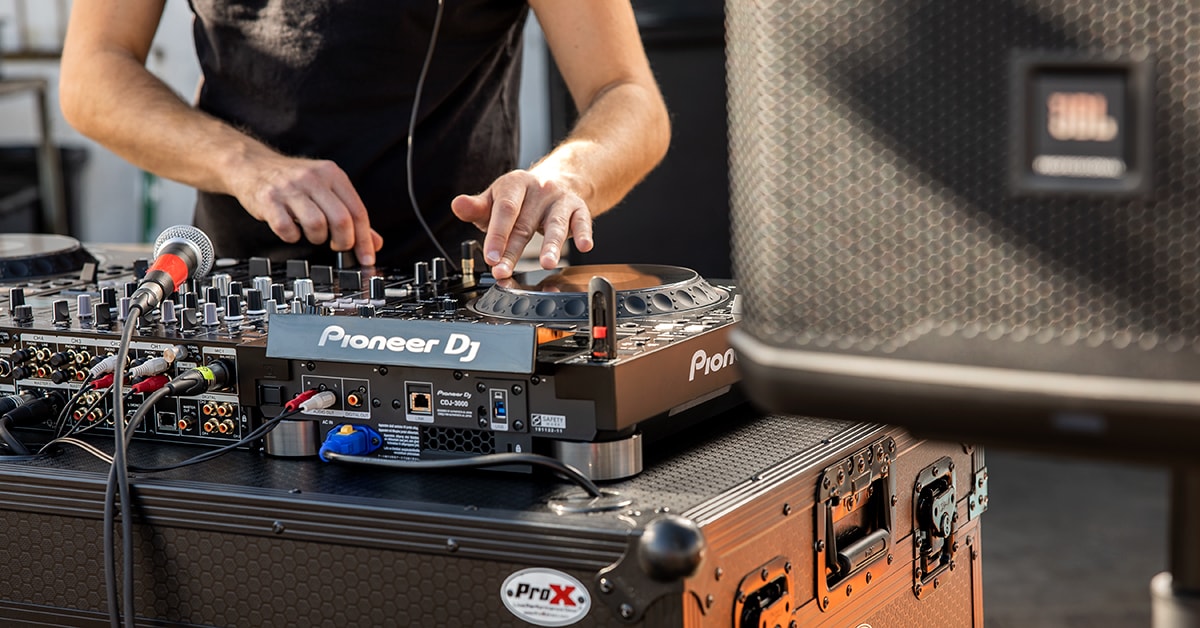Want to start mixing but don’t know where to begin when it comes to building out your first live DJ rig? The good news is it can be as simple or sophisticated as you want it to be. It can be as portable and self-contained as a compact all-in-one DJ controller, or as epically extra as a modular, four-deck, two-turntable-plus-two-media-player-and-mixer setup—with external effects gear if you so desire. And if you have a reliable laptop with the right specifications, you could integrate that into your setup, loaded with the DJ software of your choosing.
Regardless of your skill level and aspirations, there are a few components you’ll categorically need to complete a DJ rig for performance. The first is a sound source, which can come in the form of direct drive turntables playing vinyl, or a pair of media players, a laptop or an all-in-one controller loaded with DJ software and, of course, music. Next is a mixer to route your sound sources to, along with the necessary RCA cables, to blend your tracks together once you’ve beatmatched them on your turntables, media players or DJ software controllers. To monitor what you’re cueing up to play for the audience, you’re going to want a pair of comfortable, sturdy yet flexible headphones with earcups that swivel and isolate sound from the outside. When practicing at home, you’ll benefit from a set of monitors that deliver accurate playback. And finally, a PA system will let your audience hear your mix. Just make sure you have the right cables to hook up from your mixer output to the front-of-house mixer, if applicable, or directly to your speaker inputs. While PA systems are almost always a fixture in music-specific venues and festivals, having your own rig will give you the freedom to put on your live production for house parties, special events and other pop-up gigs where there otherwise wouldn’t already be a sound system.
Those are the absolutely necessary pieces of equipment in order to get sound from your source to yourself and the audience. There’s a high likelihood you’ll also want to equip yourself with a few other staples, like a microphone, an XLR cable for that mic, DJ table, laptop stand, road cases for your controller, mixer, media player and/or turntables, as well as some portable lighting gear to fill out your show. In this how-to article, we’ll show you piece by piece how to set up your first DJ rig—no matter the scope of your budget or DJing dreams.
Table of Contents
A Note on DJ Software
DJ Turntables—Spin With Analog or Digital
Go Modular With DJ Media Players
When to Get a DJ Mixer—and Which Kind
Setups With DJ Controllers
Monitors for DJing Practice
What to Look for in DJ Headphones
Getting a PA System for DJing
Why Every DJ Should Have a Microphone
Set It Up With DJ Tables and Laptop Stands
Light Up Your DJ Performance
Time to Break Down Your DJ Rig
A Note on DJ Software
Before we get to discussing the world of DJ gear in depth, let’s talk software for a minute. Unless you go with a purely analog vinyl setup with a pair of turntables, you’ll likely be working with DJ software. It’s a good idea to familiarize yourself with the main DJ software options that are available, including Serato, rekordbox dj by Pioneer DJ, TRAKTOR from Native Instruments and Virtual DJ. Others, like inMusic’s Engine DJ—which is the parent company of Denon DJ, RANE and Numark—are ascendent and worth considering. Each controller is only compatible with certain software, so it’s an important early decision to make since it will determine your gear options, as well as your overall DJing workflow.
DJ Turntables—Spin With Analog or Digital Vinyl
Until the dawn of media players and DJ software, being a performing DJ meant you used a pair of turntables as your sources of music while mixing. You can still opt for this old-school route, though mixing exclusively this way has long been abandoned by even the most legendary club DJs who earned their fame that way. Going all-turntable would require you to have a rather large vinyl record collection, as any music from your digital collection or streaming services would be quite literally off the table. And lugging around crates of records to and from gigs just isn’t fiscally or physically practical for most. That said, if you’re willing and able to make the investment in your physical music collection, and/or are already collecting vinyl, mixing on turntables can not only be a particularly gratifying experience, but an excellent foundation for the principles you’ll need to DJ via media players and/or controllers. An added benefit of going for turntables is the leisurely listening option of just kicking back and basking in the analog warmth and unrivaled fidelity of your records. However, there are certain features that differentiate DJ-specific turntables from ones aimed for audiophiles, which we’ll get to in a moment. As with any analog gear with moving parts, there’s a certain level of TLC required for keeping it spinning right and sounding great. Check out our assortment for vinyl cleaning products, as well as replacement cartridges, needles and slip mats for your turntable setup.
DJ turntables have specific features that make them more conducive to DJing, whereas audiophile turntables tend to sport different mechanics. The most fundamental of these is the drive system design, of which you have two options: direct drive or belt drive. A DJ turntable is set in motion by a direct drive, which utilizes a large, high-torque motor directly under the platter. This allows for a quick start—it’s brought up to speed almost immediately—and much greater speed/pitch control than a belt-drive system. Plus, when the motor is off, the platter can spin freely without resistance. The main drawback of direct drive systems for audiophiles is that the motor’s proximity to the platter can introduce some slight rumble and minor distortion. Conversely, a belt-drive system aims to isolate the motor—and resultant mechanical vibration—from the platter as much as possible, and achieves this by using a rubber belt as the conveyor of motion between the two. Many belt-drive turntables also suspend the motor to reduce any problematic vibrations, and some even house the motor in a separate housing altogether. What makes these effectively unusable for DJs is they can take several seconds to be brought up to speed, and usually only offer 33-1/3, 45 and maybe 78 rpm settings, without the full, continuous range of speeds that direct drives do. Also, while belt drives are built for speed stability, they undergo quite a bit of wear and tear when manipulated to go different speeds or in reverse.
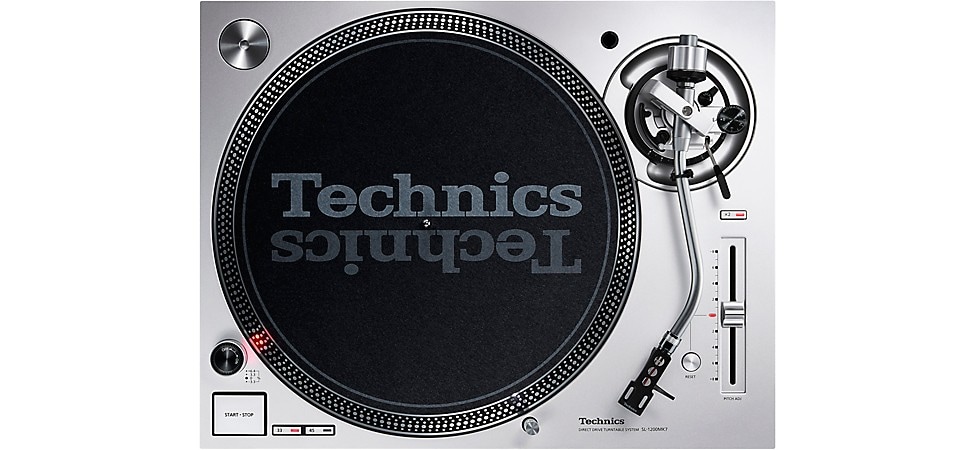
Pictured: Technics SL-1200MK7S Direct-Drive Professional DJ Turntable
For beginner DJs on a budget, the Audio-Technica AT-LP140XP delivers the direct drive functionality and control you’d expect from a best-selling DJ turntable. Its heavy-duty construction and mass-damped aluminum die-cast platter is built to resist vibrations in the loudest environments. It also takes many of its design cues from the iconic Technics SL1200, a longstanding pro DJ turntable and arguably the only industry-standard high-end model that’s still in production. The Technics SL1200MK7S is the present-day professional go-to turntable, and considering its exceptional build quality and feature set, it’s clear why the series has stood the test of time since its debut in 1972. A sublime combination of stable rotation, powerful torque and a vibration-absorbing chassis have primed the SL1200 to be a musical instrument—and the ultimate DJ turntable. And it continues to evolve. With its updated direct drive motor featuring even greater torque and brake speed adjustment than its predecessors, the MK7S boasts audiophile-grade sound with ideal mechanics for DJing.
When paired with a laptop and DVS (digital vinyl system) interface, turntables can also play a software-specific timecode control vinyl—letting you use your turntable as a DJ software controller. All four of the most popular DJ software types—Serato, Native Instruments’ TRAKTOR, Virtual DJ and Pioneer DJ’s rekordbox—offer this technology when you use a setup consisting of their proprietary timecode control vinyl, interface and DVS software. This has made turntables endlessly versatile for DJs, letting you bypass the need for carrying crates of records with you to your gig. Just like analog vinyl, digital control vinyl will need to be regularly cleaned and eventually replaced to keep spinning at peak performance.
Go Modular With DJ Media Players
Even as laptops with DJ software have been increasingly integrated into DJ setups, many professionals—as well as those choosing to optimize their workflow at venues with established DJ rigs—opt for using media players with a standalone mixer. These are modular units that have a jog wheel and a screen to show useful information, like track data, time, BPM and waveform. Representing a major milestone in digital DJing, they were designed to save the space, time and effort that DJing on vinyl necessitates. While there are media players from various manufacturers available today, like Denon DJ and Gemini, the industry standard since the ’90s has been the Pioneer DJ CDJ series, which—hence the name—included a CD player. The CDJ-500 broke ground in 1994 as the first CD DJ player, which revolutionized DJing with its ability to play, scratch and otherwise manipulate audio from CDs using jog wheels. Now, the current CDJ-3000 no longer has the CD slot, but offers USB and SD card ports instead. Because the CDJ line is so ubiquitous, it’s often a fixture at venues and DJ shows, and DJ-specific show promoters and venues will often supply a pair of CDJs at the DJ table, allowing you to just pop in your USB drive and spin your set. Because there’s little variation between each CDJ model, so long as you’re familiar with the basic layout and functions on one of the CDJs, playing on another is relatively seamless. And, since they utilize Pioneer DJ’s proprietary DJ software, rekordbox, you still can use your rekordbox-equipped laptop to host your display, settings and/or music.
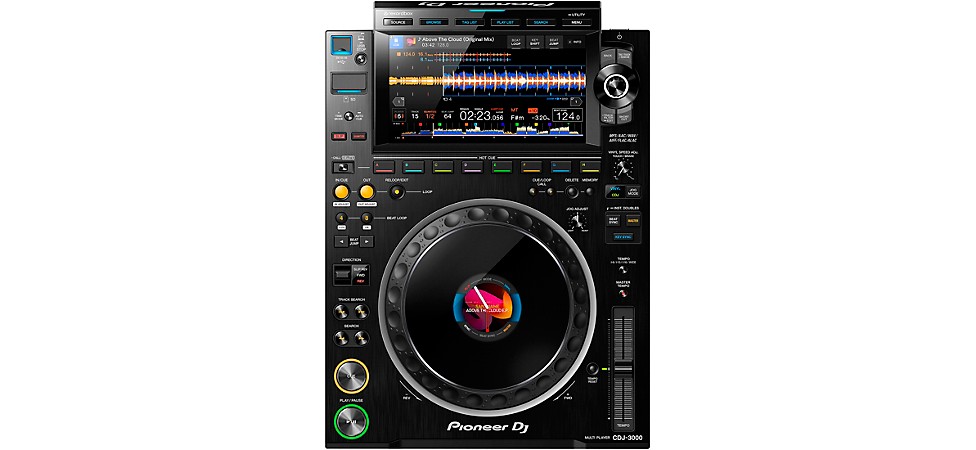
Pictured: Pioneer DJ CDJ-3000 Professional DJ Media Player
The CDJ has a more budget-friendly little sibling, the Pioneer DJ XDJ-700 media player. It’s furnished with most of the functionality of the CDJs, though it has fewer physical buttons, where those controls could be found on the XDJ’s 7" touchscreen display. Because they use the same rekordbox software and share a similar layout, transitioning to and from XDJ and the CDJ is smooth.
When to Get a DJ Mixer—and Which Kind
If you’re using a pair of turntables, media players—or both—you’ll need a standalone mixer to blend your sources together with full functionality. The connection is made via stereo RCA cables from your source output into your mixer input. All-in-one controllers include a built-in mixer, so there’s no need to get a separate, modular mixer. There are two main types of DJ mixers: club style and scratch style. They both serve common functions in that they input your signals, let you mix and then output your mix. But the way they’re laid out is fundamentally different, so it’s important to understand what each does before going in on your investment.
Club-style mixers are the more versatile type—a jack of all trades. They tend to have a larger effects section, making them good for a wide variety of applications, though they tend to lack some of the scratch-specific features that purpose-built scratch mixers have. For example, scratch mixers tend to sport easily visible and accessible paddles in the middle of the unit to toggle effects, and sometimes have a pad section for triggering samples. Conversely, because scratch mixers are meant for, well, scratching, they are built to be streamlined for that style and may lack the versatility needed to play other types of sets.
Another factor is the number of channels and inputs on the mixer. Both types can have more inputs than they do channel faders, allowing you to choose which inputs are being mixed on your channels. Many club mixers have four physical channels, whereas scratch mixers tend to have two. So, while scratch mixers can also have multiple inputs on the back panel, for those who intend on using multiple sets of decks, samplers, drum machines or other instruments, club mixers will likely be the ideal option since those extra channels are more readily available on the mixer. If you plan on using a microphone, or two, make sure you go with a mixer that can accommodate your mic input, EQ and effects needs as well. And if you want to implement external effects gear, making sure your mixer has the necessary sends and returns will allow you to send a dry (unprocessed) signal out to your effects unit via the send, and receive the wet (processed) signal back via the return.
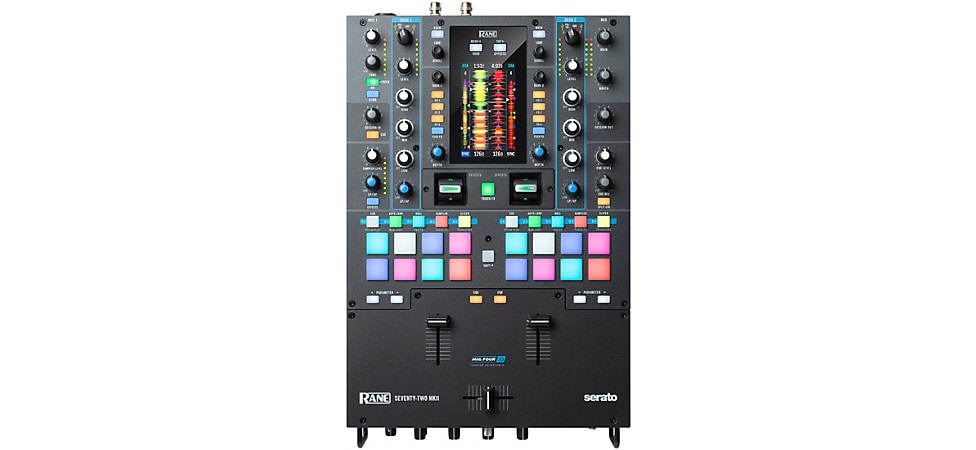
Pictured: RANE SEVENTY-TWO MKII Battle-Ready 2-Channel DJ Mixer
Most DJ mixers include an audio interface, which, in addition to control-over-laptop software, will let you record your mix to your laptop via USB. You can both send and receive audio from your laptop this way. This is also a handy feature if you intend on livestreaming your performance. For a step-by-step explanation on livestreaming check out our article on how to stream your DJ set. Speaking of USB, some mixers include two USB inputs so that you can plug in two laptops at once, allowing for seamless changeovers.
How a mixer interfaces with DJ software is also worth considering. While many club mixers can work with DJ software via MIDI or the audio interface within the mixer, most scratch mixers are specifically designed for software. This is especially the case for Serato, which has a strong foothold in the scratch DJ and hip-hop genres, with its scratch-friendly feature set. As a result, most scratch mixers tend to be Serato-compatible. The battle-ready RANE SEVENTY-TWO MKII two-channel mixer offers touchscreen control of both its own internal hardware and Serato software. Even Pioneer DJ—having mixer units like the DJM-250MK2 that only work with their in-house rekordbox software—has mixers that also work with Serato, like the DJM-S5. For more info on what to look for, and our recommendations, be sure to read our article on the best DJ mixers.
Lastly, especially if you plan on using IEMs (in-ear monitors), you’ll need a mixer with a split cue function. This will let you listen to your house mix in one ear and your cue in the other. You can also do this with regular DJ headphones, if you find that workflow suits you better than switching back and forth between listening to your headphones and speaker monitor cue.
Setups With DJ Controllers
The best way to think of a DJ controller is in terms of how it acts as a remote control for DJ software, like a mouse or keyboard would do in relation to a computer. That DJ software can be loaded on to your laptop, or even the controller itself, if it’s equipped with that functionality. Technically, you could perform most of your basic functions on your DJ software-outfitted laptop, but you’d lack the two-handed workflow needed to, you know, DJ. Enjoying that tactile, simultaneous control of jog wheels, faders, knobs and buttons is something you simply can’t achieve from clicking away on a laptop. That’s why a control surface is not only nice to have, but necessary if you decide on mixing with DJ software. There are two main types of controllers: ones that need a computer, tablet or phone loaded with the necessary software, or all-in-one, standalone setups equipped with a USB port and DJ software. Both types usually include a built-in mixer section, meaning the only other gear needed to mix is a pair of headphones and speakers. And while they can vary in size, controllers tend to be more compact than other modular media player or turntable setups, thus being a safer bet for venues with tiny DJ booths.
The most popular type of setup is the non-standalone variety, like the affordable, user-friendly Pioneer DJ DDJ-FLX4 2-channel controller. These controllers require another device, usually a laptop, that hosts your DJ software—and usually come with at least a “lite” version of that software. For instance, the FLX4 comes with Serato Lite. While many of these controllers offer compatibility with mobile devices, and may suffice for beginning practice and familiarizing yourself with your DJ software in a pinch, going this route is ill-advised in the long term. During a gig, having that extra screen real estate, and not having to lean over your rig and squint at your phone, will make your set more enjoyable for everyone. Not having to worry about pressing the wrong icon on your tiny screen—or having an embarrassing ringtone or app notification “Diiing!” go off mid-set—will give you the peace of mind to focus on being the master of the vibe. You can make any adjustments to the software settings on your computer, and then use your controller to beatmatch and mix your tracks together. Keep in mind, in this scenario, all the audio DSP (digital signal processing) heavy lifting, including playback, is being done by your laptop. While this tends to make controllers more affordable than their all-in-one counterparts, it puts more onus on the quality (i.e., processing power, RAM, storage, operating system-software compatibility, etc.) of your computer. So, having a reasonably modern laptop with a solid-state drive, or opting for a USB stick to store your music, is crucial to avoid any latency issues. And of course, always check your DJ software’s system requirements, be it Mac or PC, before moving forward.
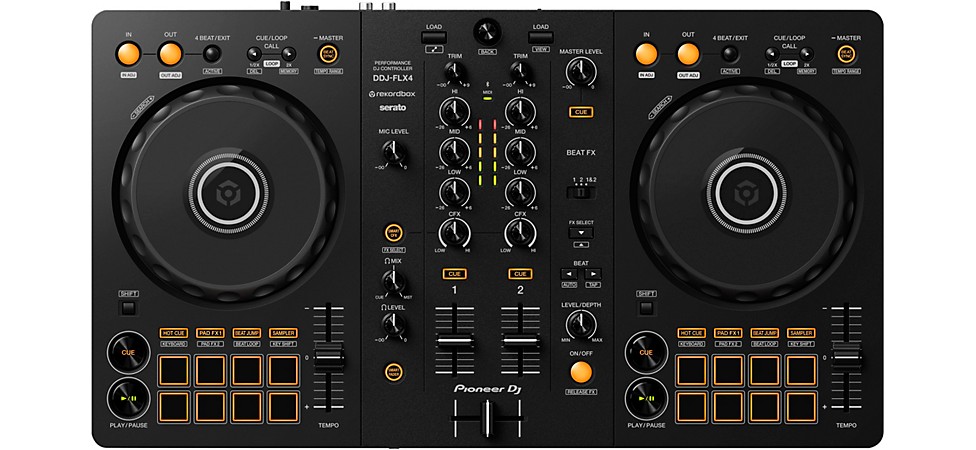
Pictured: Pioneer DJ DDJ-FLX4 2-Channel DJ Controller
Standalone controllers host your players, mixer and software with a display all in one unit. With these, all you need to mix are a set of headphones, a pair of cables to connect to your monitor or PA speakers, and those speakers themselves. This is a great option if all your DJing needs can be met with a particular all-in-one controller. It can also be a space saver and streamline your rig transport. A great entry-level unit is the Numark Mixstream Pro, which has onboard Wi-Fi for access to streaming services like TIDAL, Beatport LINK, Beatsource LINK, SoundCloud Go+ and Dropbox. With access to these, your virtual record collection is practically limitless. A true all-in-one, it also has built-in speakers and embedded controls for Philips HUE and DMX lighting, giving you unprecedented control of your show at a great value.
Pioneer DJ offers several standalone controller options, taking cues from some of their pro-level gear. For aspirational beginners and intermediate DJs looking to make the transition from bedroom and backyard to club gigs, the Pioneer DJ XDJ-RR rekordbox controller delivers functional flexibility in a lightweight, compact form factor. It inherits the fundamental performance features of the club-standard NXS2, including Hot Cues, Slip Loop and Beat FX. And for around twice the price, you can get the Pioneer DJ XDJ-RX3 all-in-one DJ controller, which borrows many of its functions from the CDJ-3000, as well as an impressive 10.1" touch display.
Monitors for DJing Practice
No matter what type of live setup you decide on, having a set of reliable monitors at home is a necessity for building and maintaining your DJing chops. You can make this connection via the booth or main outputs of your mixer via a pair of XLR, 1/4"—or sometimes even 1/8" or RCA cables for smaller monitors. Our recommendations for DJ monitors are more akin to studio monitors—and even include some speakers that are made for monitoring playback while producing music—than the floor wedges you’d use at a gig to hear yourself. This is because you (hopefully) have less outside noise and spillover to deal with at home—or wherever you practice—than you would at a venue with your PA system, and possibly those of neighboring stages. What you want is an honest representation of your audio, and accuracy is crucial, especially while practicing. And for DJing, being able to decipher your lows, mids and highs during practice will benefit your audience’s listening experience in the end. To streamline your setup, and optimize your audio, you’ll want active monitors as opposed to passive ones, as those would require a separate power amp. Plus, active speaker cabinets include power amps that are optimized for the speaker components. Sometimes simpler is better.
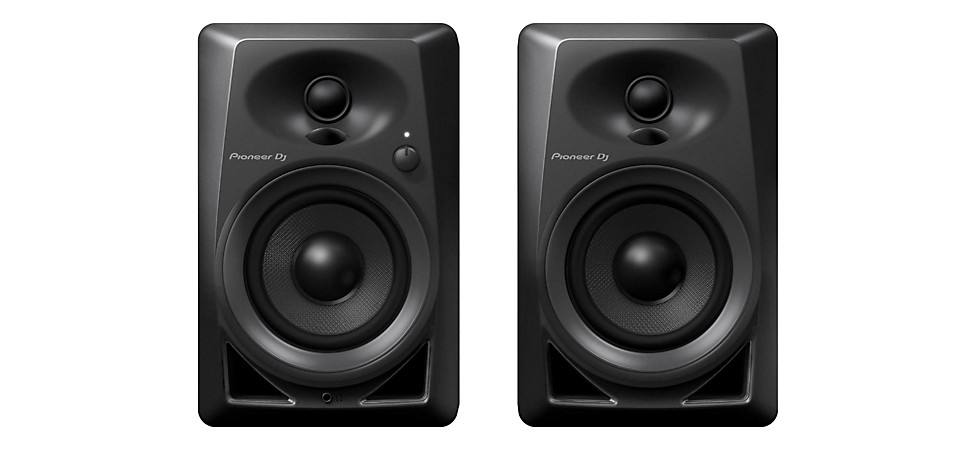
Pictured: Pioneer DJ DM-40 4" Powered Studio Monitors
One of our best-sellers is the Pioneer DJ DM-40 4" bookshelf monitors. Though compact, they deliver a tight low-end response via a front-loaded bass reflex system, while their tweeters produce an excellent stereo image with a wide sweet spot—meaning you can move about your booth without worrying too much about how it affects your sonic perception. Another affordable 4"-woofer option is the Hercules DJMonitor 42, and the PreSonus Eris E35 3.5" monitors punch above their weight with a special edition of the Studio Magic suite included. For practice rigs, many DJs also swear by home studio classics, like the KRK ROKIT Series.
What to Look for in DJ Headphones
Unless you opt for in-ear monitors, headphones are an essential part of any DJ’s workflow. They allow you to privately listen in as you cue up a track to beatmatch with the track the audience is currently hearing. But not just any pair of cans will do. While preferences vary based on the type of music and where it falls on the frequency spectrum, DJs gravitate to certain features that make them ideal for DJing. One of these is the earcups’ ability to swivel for one-ear-on, one-ear-off listening. When cueing up a new track, matching BPM and pitch can be much easier when listening concurrently with the current track. Another is the earcups’ sound isolation. Having earcups with a purpose-designed isolation quality is important to avoid hearing damage, let alone being able to hear your cue clearly. Lastly, you’ll be gigging with these, so having a sturdy, yet flexible set of phones will help ensure years of mixing delight.
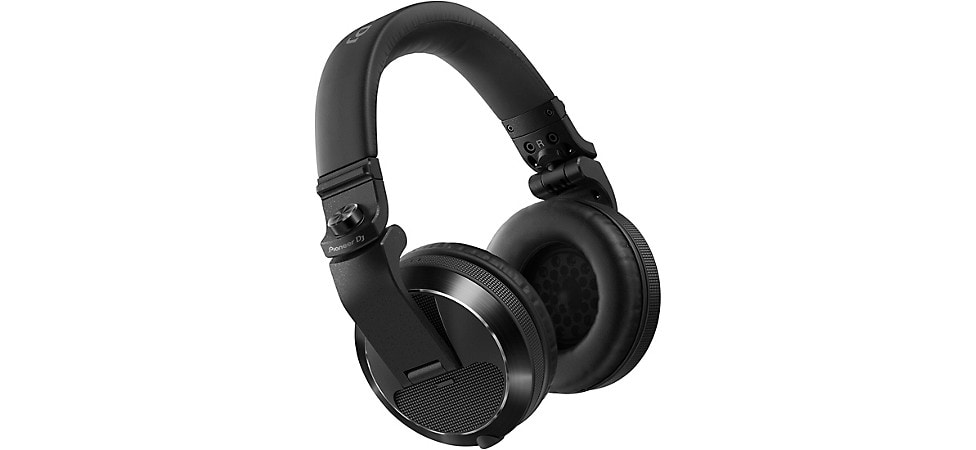
Pictured: Pioneer DJ HDJ-X7 Professional DJ Headphones
While there are many DJ-specific headphones that are purpose built for the task, like the Pioneer DJ HDJ-X7 with its generously sized, rotating earcups, some of the best headphones for DJing weren’t specifically designed for it. For example, the entire Audio-Technica ATH series is well suited for DJing, from the massively popular, budget-friendly M20x to the studio-standard M50x. Also, while headphones for DJing have an over-ear design, the Sennheiser HD 25 on-ear headphones have reached legendary status among DJs for their comfortable, lightweight design and surprisingly high-SPL vivacity. For additional insight on what makes headphones great for DJing, as well as more recommendations, have a look at our buying guide for the best DJ headphones.
Getting a PA System for DJing
If you plan on being a mobile DJ or fancy throwing your own shows from time to time, it might be worth investing in a PA system. Options are limitless, but you’ll likely benefit from a balance of portability, clarity and power. Inevitably, the more SPL, especially in the lower frequencies, the more you’ll have to lug around, so visit your local Guitar Center to test out our range of speakers to see what’s best for your needs.
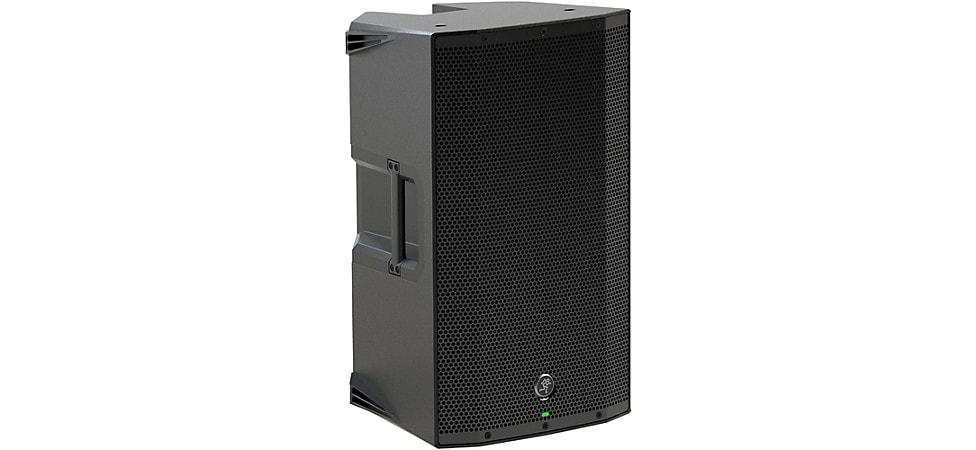
Pictured: Mackie Thump12A 12" Powered Loudspeaker
Since their debut, the Mackie Thump Series has attracted gigging DJs, as it presents a happy medium when it comes to sonic output, performance features and ease of transport. It boasts a slew of gig-optimizing controls and signal processing power, feedback suppression and even has a mic input with a feature that automatically “ducks” your music as you speak. The Thump Series loudspeakers are available in 12" and 15" sizes, while the subs have 15" and 18" varieties. To get the lowdown on what makes for a great mobile DJ PA system, check out our video with DJ Jansport J on the Mackie Thump Series.
Why Every DJ Should Have a Microphone
Whether your show includes a planned element of emceeing, hyping up the crowd, making announcements or not, it’s always a good idea to have a mic on hand. Many mixers will include a mic input, whether an XLR or 1/4" jack, as well as gain control. Plus, thanking your audience for coming out and acknowledging the other acts, venue, city, event organizers and/or guests of honor is always a classy gesture. Just make sure you test for feedback before cranking it up during your set. You can mitigate the chances of getting hit with that dreaded screech or relentless hum cycle by ensuring the PA speakers are turned away from you, and as far away from the mic as possible. If you have booth speakers to monitor your mix, be wary of its level and use your EQ if possible and when necessary. Ideally, you can test this out during soundcheck with the music and mic volume at show levels. But if that’s not possible, lower the booth monitor output, turn the mic gain up gradually until you can hear yourself, and be ready to roll that gain level back or cut problematic frequency bands via the EQ control on your mixer.
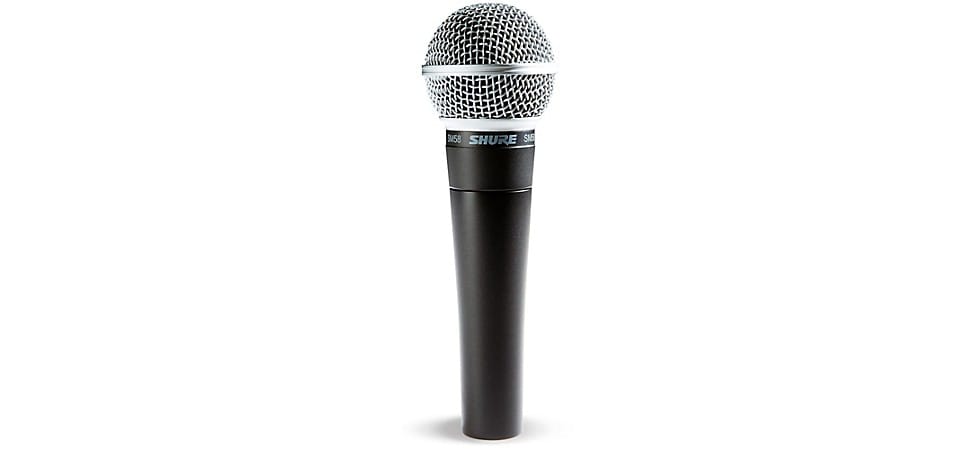
Pictured: Shure SM58 Dynamic Microphone
With those tricks in mind, the type of microphone you choose is essential to both sounding great and lessening the risk of feedback. Select a dynamic mic, which can withstand higher SPL (sound pressure level), pick up less background noise and give you superior durability for gig-to-gig use compared to its condenser mic counterparts. Be sure to speak clearly and directly into the mic, but avoid cupping it with your hand around the capsule, as that can reflect the sound and introduce feedback. You’ll also want a mic with a cardioid polar pattern, which best picks up sound from directly in front of the capsule, while bolstering excellent off-axis rejection—meaning anything on the other side of the mic, like spillover from the PA, will be significantly dampened. For these qualities, along with its vocal-flattering EQ curve and legendary reliability, the Shure SM58 handheld dynamic mic is an industry standard for live vocalists. Given its first-rate reputation, it makes for a surprisingly affordable and wise addition to any performing DJ’s setup. For more recommendations, have a look at our buying guide for live vocal microphones.
Set It Up With DJ Tables and Laptop Stands
Once you have all your DJ gear accounted for, you’re going to need something to set it on at your shows—ideally sturdy, portable and the right size for your setup. Some DJs do with a generic plastic fold-up table, but if saving space and looking professional is a priority to you, getting a purpose-built DJ table should be, too. Renowned for their road and flight cases, Odyssey has an ATA flight case that functions as a folding stand for DJ equipment. And if you incorporate a laptop into your setup, it’s definitely worth investing in a solid laptop stand that’s height adjustable and has a small footprint. A great example of this is this DR Pro DJ laptop stand bundle, which includes a handy, removable shelf for a drum machine, digital interface or effects device.
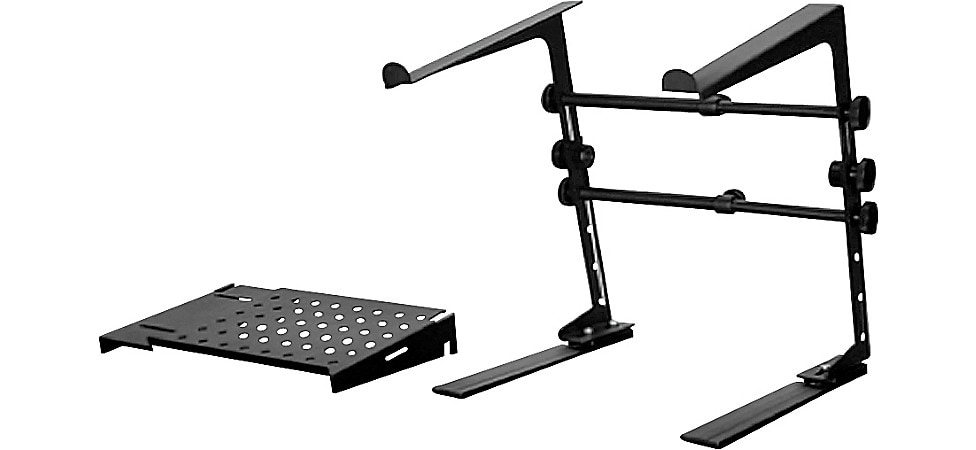
Pictured: DR Pro DJ Laptop Stand and Shelf Bundle
Many DJs will use road cases for their individual DJ gear to form a “riser” of sorts on top of their table. You can set your turntables on top of their cases, your mixer on its cases, etc., to give your setup a more tiered look, or if you need some extra height that your table can’t adjust to. And finally, to give your setup a more clean, cohesive look, you can use a black table cloth, or DJ-table-specific cover to hide your cables and DJ table.
Light Up Your DJ Performance
For those planning on throwing their own parties and events, some lighting could be in order. Lighting is a science and an artform unto itself, but it can elevate your DJ set to the next level. And additional stage effects like fog machines can help add another dimension to your lighting. Pro lighting setups can have an astronomical price tag, but there are plenty of relatively inexpensive alternatives that will illuminate your show with customizable effervescence. One of these is the CHAUVET DJ GigBAR family. Blending pack-and-go portability and options to run lasers, LED derbies, wash lights and strobe lights, they’re an enticing addition to a working DJ’s setup, and sure to dazzle the crowd. Check out our interview with Geoff Short from Chauvet DJ to learn about the latest member of the family, GigBAR Move + ILS.
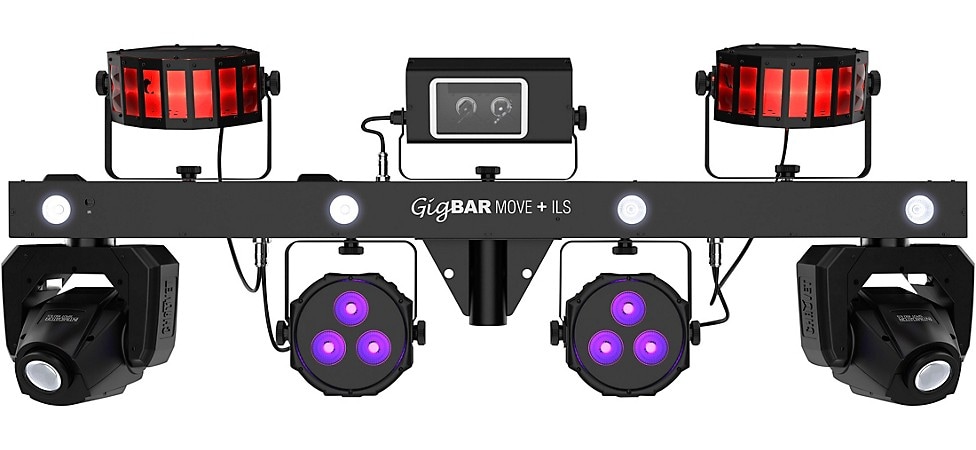
Pictured: CHAUVET DJ GigBAR Move + ILS 5-in-1 Lighting System
Time to Break Down Your DJ Rig
Now that you’re familiar with the ins and outs of what it takes to build a live DJ rig, you can better decide which components work best for your DJing wants and needs. Whether you seek the simplicity of an all-in-one form factor, or you prefer the interchangeability and customizable nature of modular setups, there is a DJ rig to fit your style and budget. Come visit your local Guitar Center, and our associates are happy to help you design the DJ setup of your dreams.




